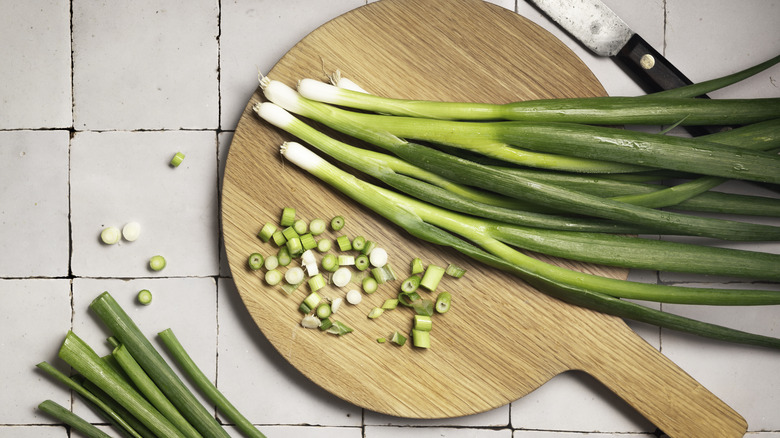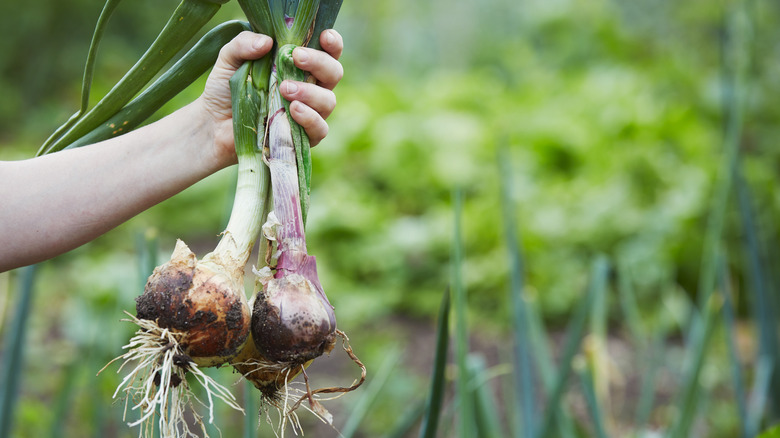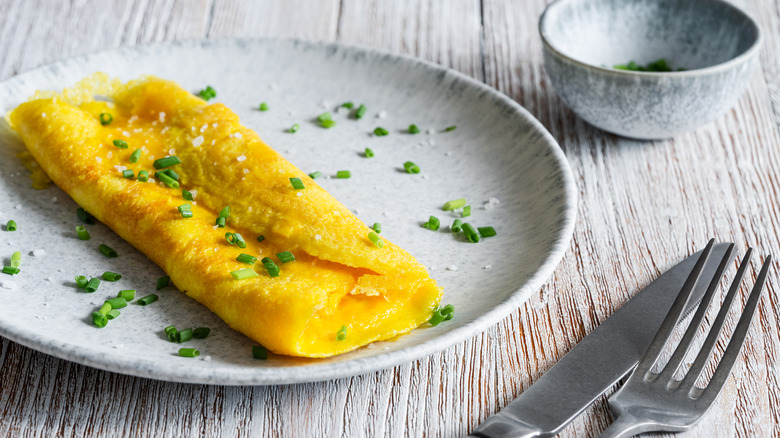Is There A Difference Between Green Onions And Chives?
An onion may be a many-layered thing, but here's something it's not: a chive. That goes for green onions, too. As their name suggests, green onions are often a younger version or a hybrid of the mature, full-sized onions you find at the grocery store, while chives are another species altogether. As befits their different lineages, green onions and chives have different roles to play in the kitchen and at the dining table. A bit hardier, green onions can stand up to sautéing, grilling, and the like; tender and delicate, chives are usually treated more like a soft herb, stirred into a dish in the final moments of cooking or added afterward for flavoring or garnish — like finishing fancy French omelets (like this one from "The Bear").
What unites them, though? Both come from the genus Allium. This is a big and eclectic clan whose members include not just onions and chives but also leeks, ramps, garlic, shallots, and many more vegetables. As diverse as this group is, its members share some common characteristics, one of which is flavor. Though it can range from subtle (chives) to intense (raw garlic), you can expect a measure of pungency when you bite into an allium. The other is nutritional value. Alliums contain a number of health-boosting compounds including flavonols, which have antioxidant properties that can help lessen the risk of cancer and heart disease. Let's get to know this crew a little better.
An introduction to alliums
Another thing about alliums: They're an astonishingly versatile cooking ingredient. They're present at the very beginning — sautéed onions (along with other aromatics) are crucial building blocks in the European culinary canon — and at the end, too, with chives serving as a popular garnish for many dishes. They don't even have to be a supporting player; think of the starring role leeks play in classic recipes like vichyssoise and leeks vinaigrette. In the U.S. today, the most prominent member of this group is the species Allium cepa — that's the bulb-shaped onion sold dry and at room temp in supermarkets today, which you can buy in its younger form as a green onion.
A. cepa is from somewhere in Eurasia — probably the vicinity of present-day Afghanistan, Iran, and Russia. The leeks you see in the store (A. ampeloprasum) come from wild leeks found all over the world, and garlic (A. sativum) may have originated in a large region of Asia known as "the garlic crescent." North America has its own native alliums, including meadow garlic (A. canadense) and ramps (A. tricoccum). One of these — it's not clear which, exactly — is thought to have given one of our major cities its name: "Chicago" comes from an indigenous term referring to a smelly onion that once grew there in the marshy terrain. Ramps' native status is reason to be proud of them, though their skyrocketing popularity in recent years has given way to over-harvesting fears.
Green onions versus chives
In this comparison, "green" is probably best taken to mean "young," since otherwise it's a bit of a misnomer: Chives are green through and through, whereas green onions (aka scallions — a nomenclature discussion for another day) are white on the bottom, green on the top. Chives are smaller, thinner, and daintier than green onions. The plant is from the species A. schoenoprasum, which has been cultivated for hundreds of years in Europe and for millennia in China. In Asia, it's appreciated for both its culinary and medicinal values (though it shouldn't be confused with garlic chives, another regional vegetable that's a different species altogether).
Are green onions and chives interchangeable in cooking? Not exactly, though it wouldn't necessarily be a disaster if you mixed them up. Scallions' relative toughness means they can withstand heat better than the more delicate chives — you can sauté them in stir-fries, char them on the grill, or fold them into a frittata — and their relatively robust flavor means they're good for marinating in something like scallion sauce, a fantastic burger topping. Chives are better thought of as a soft herb, like parsley or basil — at their best when they're fresh or minimally cooked, tossed into a dish at the last moment to add a burst of fresh flavor.


